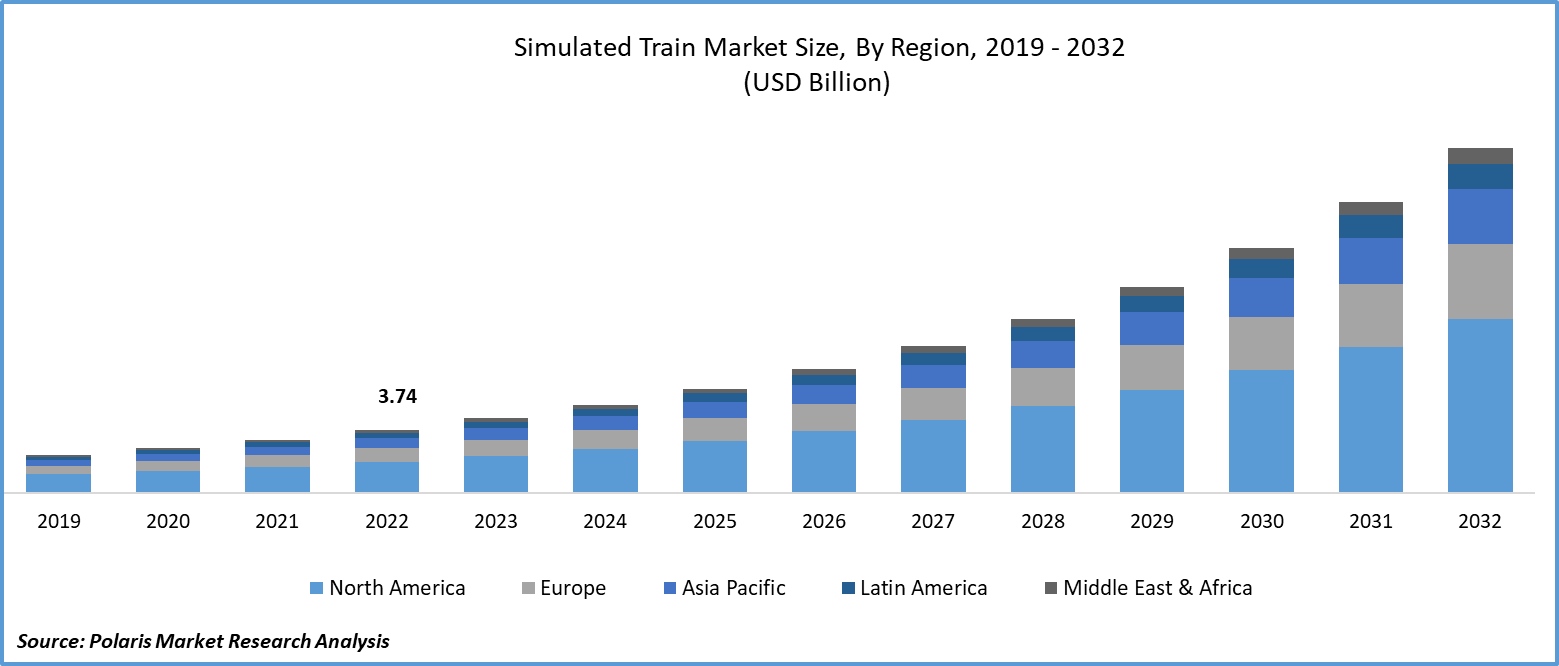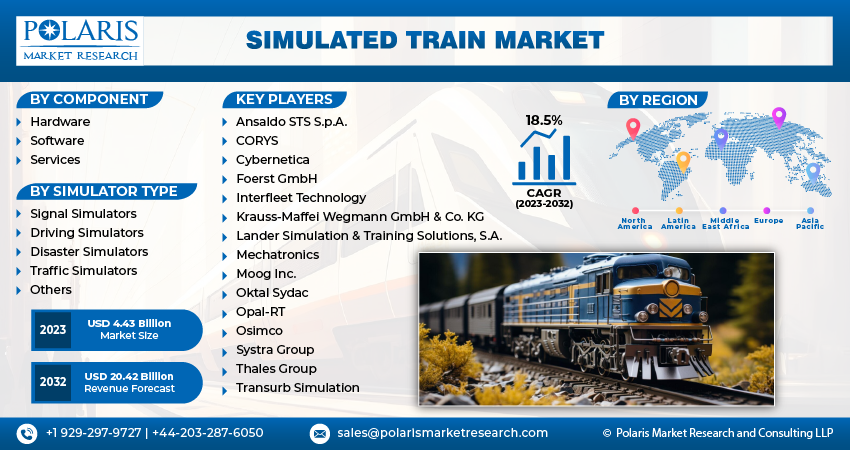
Simulated Train Market Share, Size, Trends, Industry Analysis Report
By Component (Hardware, Software, Services); By Simulator Type (Signal Simulators, Driving Simulators, Disaster Simulators, Traffic Simulators, Others); By Region; Segment Forecast, 2023 - 2032
- Published Date:Dec-2023
- Pages: 117
- Format: PDF
- Report ID: PM4091
- Base Year: 2022
- Historical Data: 2019-2021
Report Outlook
The global simulated train market was valued at USD 3.74 billion in 2022 and is expected to grow at a CAGR of 18.5% during the forecast period.
In recent times, the transportation industry has undergone a significant shift towards innovative and sustainable solutions. One notable advancement in this realm is the emergence of the simulated train market, an avant-garde concept that amalgamates virtual reality, artificial intelligence, and advanced engineering to transform our engagement with trains. This market embodies a forward-looking vision for transportation, offering a multitude of advantages, including heightened safety protocols, cost-efficient solutions, and an immersive passenger experience.

To Understand More About this Research: Request a Free Sample Report
Simulated trains are the result of the fusion of diverse technologies. At its core, this market employs virtual reality (VR) and augmented reality (AR) to craft highly authentic and immersive environments. By donning a VR headset, passengers are transported to a digitally crafted realm that mirrors the sensation of riding an actual train. Furthermore, advanced haptic feedback systems heighten the sensory encounter by replicating vibrations and motions reminiscent of real-world train travel.
Moreover, the integration of artificial intelligence (AI) assumes a pivotal role in the functioning of simulated trains. AI algorithms oversee various facets, including route optimization, predictive maintenance, and even simulated interactions with passengers. This not only amplifies the effectiveness of train operations but also ensures a seamless and secure voyage for all passengers.
- For instance, in October 2023, The Marlborough Police entered into a partnership with Civil Defence, Hato Hone Saint John, KiwiRail, Fire and Emergency New Zealand, Pounamu Tourism Group and Steam Incorporated for an exercise aimed at evaluating and rehearsing emergency protocols in the event of an incident involving a passenger train.
However, technological integration, initial investments and regulatory hurdles are few factors hampering the market growth. The seamless fusion of virtual reality, artificial intelligence, and engineering poses a substantial technological challenge. Ensuring these components work cohesively and reliably demands rigorous testing and development.
Also, the introduction of simulated trains may encounter regulatory hurdles and safety standards that differ from traditional rail systems. Establishing a framework that ensures passenger safety and compliance with existing transportation regulations is crucial. Additionally, the development and implementation of the required technology infrastructure can be financially demanding. Securing funding and garnering support for this innovative approach may pose initial barriers.

For Specific Research Requirements: Request for Customized Report
Thus, the simulated train market represents a revolutionary step towards the future of transportation. Overcoming technological and regulatory challenges is crucial, but the opportunities for enhanced safety, cost efficiency, and an immersive passenger experience make it a venture worth pursuing. With careful planning and strategic implementation, this innovative concept holds the potential to revolutionize the way we perceive and engage with train travel.
Growth Drivers
- Increased focus on technical advancements
The primary driving force behind the simulated train market is the urgent need for innovative and safer training environments in the transportation sector. As traditional methods fall short in preparing operators and maintenance personnel for complex real-world scenarios, simulated trains step in to fill this crucial gap. The integration of cutting-edge technologies like virtual reality (VR) and artificial intelligence (AI) enables hyper-realistic training simulations, allowing personnel to practice emergency responses and operational procedures in a controlled, risk-free environment.
This emphasis on comprehensive training not only enhances safety measures but also addresses a critical concern in the transportation industry. As a result, the simulated train market is witnessing rapid growth and adoption, poised to revolutionize the way professionals in the field are prepared to handle the challenges of real-world train operations.
Report Segmentation
The market is primarily segmented based on component, simulator type, and region.
|
By Component |
By Simulator Type |
By Region |
|
|
|
To Understand the Scope of this Report: Speak to Analyst
By Component Analysis
- Software segment is expected to witness highest growth during forecast period
The software segment of the simulated train market is experiencing a surge in growth, marking a significant change in how train operations are managed and experienced. Advanced software solutions are now the backbone of this transformation, introducing a range of innovative features and functionalities.
Sophisticated algorithms are leading the way, carefully simulating the complexities of train movements, track conditions, and environmental factors, resulting in highly realistic virtual environments that mirror actual train travel. Artificial intelligence (AI) integration within the software optimizes operations, from route planning to predictive maintenance, improving overall system efficiency and safety.
Furthermore, the software enables real-time monitoring and feedback, allowing for immediate responses to any anomalies or hazards. With specialized training modules embedded in the software, operators and maintenance personnel can receive comprehensive training, ensuring they are equipped to handle diverse operational scenarios. This growth in the software segment is driving a paradigm shift in the simulated train market, promising a future where cutting-edge technology seamlessly integrates with rail transportation, revolutionizing safety, efficiency, and the overall passenger experience.
By Simulator Type Analysis
- Driving simulators segment accounted for the largest market share in 2022
The driving simulators segment accounted for the largest market share in 2022 and is likely to retain its market position throughout the forecast period. They are offering a revolutionary approach to training and skill development for train operators. These simulators employ advanced technology, including realistic control interfaces, high-fidelity visual displays, and immersive environments, to create a true-to-life training experience. Trainees can practice various scenarios, from routine operations to emergency responses, in a safe and controlled virtual setting.
A primary catalyst for this expansion is the growing priority placed on safety and operational proficiency within the transportation sector. Driving simulators offer a secure setting for trainees to refine their skills and develop confidence in managing intricate scenarios. This, in turn, leads to heightened safety protocols and a decrease in potential risks linked to actual operational scenarios.
Moreover, the adaptability and scalability of driving simulators cater to diverse training needs, accommodating different types of trains, terrains, and scenarios. They also facilitate customized training programs, allowing operators to focus on specific skill sets or challenging scenarios. As the demand for well-trained and proficient train operators continues to rise, the Driving Simulators segment is poised to play a crucial role in shaping the future of the simulated train market. It represents a significant stride towards safer and more efficient rail transportation systems.
Regional Insights
- North America region dominated the global market in 2022
The North America region dominated the global market with the largest market share in 2022 and is expected to maintain its dominance over the anticipated period. The growth of the segment market is largely attributed to the convergence of technological advancements and a burgeoning emphasis on safety. The region's transportation industry is increasingly recognizing the value of virtual training environments for operators. These simulations offer a risk-free platform to refine skills, respond to emergencies, and optimize operational efficiency. Additionally, the cost-effectiveness and adaptability of simulated trains make them an attractive prospect for modernizing rail transportation. With a rising demand for innovative, safe, and efficient solutions, North America stands at the forefront of simulated train market expansion.
In the Asia-Pacific region, the simulated train market is experiencing remarkable growth, driven by a surge in technological innovation and a heightened focus on transportation efficiency. Governments and industry leaders are recognizing the immense potential of virtual training environments for train operators. These simulations offer a controlled space to enhance skills, tackle emergencies, and optimize operations. The cost-effectiveness and adaptability of simulated trains make them an attractive proposition for modernizing rail networks across the region. With a burgeoning demand for advanced, safe, and efficient transportation solutions, the Asia-Pacific region is witnessing a significant surge in simulated train market expansion.
Key Market Players & Competitive Insights
The simulated train market is fragmented and is anticipated to witness competition due to several players' presence. Major service providers in the market are constantly upgrading their technologies to stay ahead of the competition and to ensure efficiency, integrity, and safety. These players focus on partnership, product upgrades, and collaboration to gain a competitive edge over their peers and capture a significant market share.
Some of the major players operating in the global market include:
- Ansaldo STS S.p.A.
- CORYS
- Cybernetica
- Foerst GmbH
- Interfleet Technology
- Krauss-Maffei Wegmann GmbH & Co. KG
- Lander Simulation & Training Solutions, S.A.
- Mechatronics
- Moog Inc.
- Oktal Sydac
- Opal-RT
- Osimco
- Systra Group
- Thales Group
- Transurb Simulation
Recent Developments
- In January 2022, CM Labs launched the 2022A version of the Vortex Simulator, featuring improved locomotive modeling to provide even more precise virtual training experiences.
Simulated Train Market Report Scope
|
Report Attributes |
Details |
|
Market size value in 2023 |
USD 4.43 billion |
|
Revenue forecast in 2032 |
USD 20.42 billion |
|
CAGR |
18.5% from 2023 – 2032 |
|
Base year |
2022 |
|
Historical data |
2019 – 2021 |
|
Forecast period |
2023 – 2032 |
|
Quantitative units |
Revenue in USD billion and CAGR from 2023 to 2032 |
|
Segments covered |
By Component, By Simulator Type, By Region |
|
Regional scope |
North America, Europe, Asia Pacific, Latin America; Middle East & Africa |
|
Customization |
Report customization as per your requirements with respect to countries, region and segmentation. |
